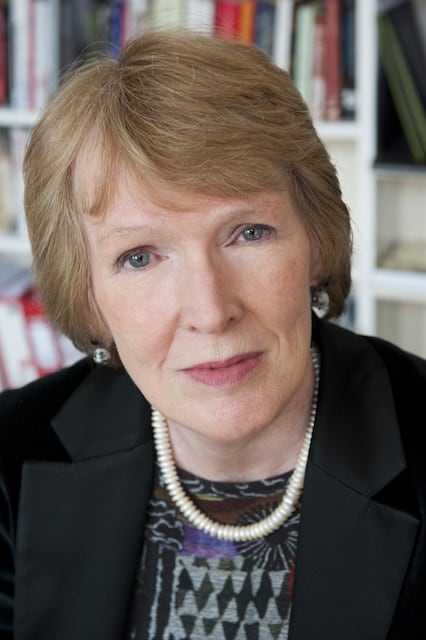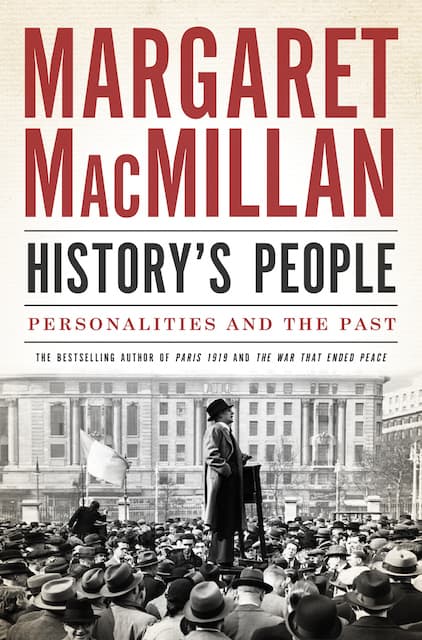[dropcap]You[/dropcap] may never have heard of Harry Kessler, but you may want to read his diary. Born into German nobility in 1868, he saw first-hand the remarkable changes that swept Europe over the last half of the 19th century and the first half of the 20th. Kessler eventually died an exile from his homeland in 1937. His address book is rumoured to have contained over 10,000 names including Auguste Rodin, George Bernard Shaw, and Kaiser Wilhelm II. Perhaps most importantly, he kept a detailed journal throughout his life, a journal that allows us to view history through his eyes.
Kessler is one of the many historical figures, some widely known and some wonderfully obscure, whose stories make up History’s People: Personalities and the Past, the 2015 Massey Lecture Series and accompanying book, written by celebrated Canadian historian Dr. Margaret MacMillan.
Currently a professor of history at both U of T and Oxford, MacMillan has published numerous books over a teaching career that spans 40 years. I spoke with her in the wake of her last Massey Lecture stop — Koerner Hall in Toronto — to discuss History’s People, working with the CBC, and her own approach to the field of history.
WHY HISTORY’S PEOPLE?
The Massey Lectures is an annual lecture series first commissioned by the manager of english language CBC networks, H.G. Walker, in 1961. Walker hoped that the lectures would “make significant contributions to public awareness and understanding and … further development of the art of broadcasting.”
Today, the CBC invites noted scholars to give original lectures on a subject of their choice on five university campuses across Canada, with an accompanying book printed by House of Anansi press.
When MacMillan was asked to present the 2015 Massey Lectures, she was inspired by a simple, but compelling historical inquiry: the role of individuals.
“I think what I’m trying to say is that, for various reasons, people matter in history,” says MacMillan as we sit down to talk over Skype; she returned to Oxford shortly after completing the Toronto leg of her series.
“Sometimes they are people who helped create history by writing records, but sometimes they make a difference at particular times. So, I’m not saying that individuals are more important than the great currents of history, I’m saying you need to look at both.”
The figures written about in History’s People are not given full length biographies. Rather, MacMillan sometimes looks at the most impactful moments of her subjects’ lives. Sometimes she examines their specific actions, and sometimes at specific aspects of their character. This approach, MacMillan says, serves to explore how these individuals fit into our understanding of the times in which they lived in and events they lived through.
“I think if you focus too much on biography then of course you are leaving out great social or political or economic or intellectual changes,” she says, adding that, “There has always been a tension between history and biography, because historians tend to think biographers don’t get the history right, and biographers tend to think that historians don’t get the people right.”
MacMillan’s cast of characters is varied. Her work includes Babur, the first Mughal Emperor of India, to Elizabeth Simcoe, wife of John Graves Simcoe, who was the first Lieutenant Governor of Upper Canada.
WWII has a substantial presence in the book; national leaders Roosevelt, Churchill, Stalin, Hitler, and Mackenzie King are all discussed, as are more humble figures such as Holocaust survivor Victor Klemperer. “It was a mix, and there were lots of people I’d love to have done, but there just wasn’t space,” says MacMillan.
Asked how she came about with her particular selection of historical figures, MacMillan tells me how she “made lists of qualities, and then…narrowed that down.”
“I thought ‘who would illustrate these things?’” she mused. MacMillan’s process is reflected in the structure of the History’s People, which is divided into chapters which are titled by qualities such as “Hubris,” “Daring,” “Curiosity” and “Observers.” Ultimately, however, it was Macmillan’s own observations and curiosities that drove the final decision on who made it into the book, and who didn’t, such is the prerogative of an historian as established as MacMillan.
“I chose to look at people in this particular book just because I wanted to,” she says. “I went partly by people I was interested in, partly by people I already knew something about, or by people I wanted to find out something about.”
APPROACHES TO HISTORY
Although MacMillan is a veteran of academia, she believes history should be an inclusive subject. Asked whether she changes her approach when writing popular, as opposed to academic, history MacMillan responds that there should be no difference between the two.
“I think good academic history should be capable of being read by anyone who is interested,” she says, “I think sometimes [the term] popular history is used…to denigrate. As if being popular is a bad thing in itself. I think there’s good history and bad history, some is popular, some is not.”
One particular approach to historical research with which MacMillan takes issue is historiography, or, what she calls in History’s People the “rather tiresome trend” of historians “looking increasingly at themselves, how they ‘created’ the past.”
The trend, she says, is not inherently problematic, but ultimately a distraction.“I think historiography is important, and we all should be aware of it” she replies, when asked to elaborate on this. “Why I find it tiresome is because I think there is a bit too much of it. I don’t think it is bad in itself, but we don’t want to be just doing that.”
Ultimately, MacMillan says, there is value in delving into historical records.
“I would hate to see historians just spending the majority of their time looking at what other historians have said about something. I believe that you should go back and look at the records, go to the archives, read what was said at the time, try and get to the documents and the material from the time.”
UNDERSTANDING PEOPLE, PLACE AND TIME
In Macmillan’s own words, History’s People has no definitive thesis, nor does it have a particular moral thrust. “I’m not a moral philosopher,” she says. “I think what historians try to do is understand how things happened in the way they happened.” Although, as MacMillan herself describes, she “may have very strong views on some of these characters,” her real goal is “to explain them and understand them.”
To illustrate this point, I asked MacMillan to elaborate on her analysis of US President Richard Nixon, a historical figure about whom she has written in the past. “Nixon’s presidency is now overshadowed by memories of Vietnam, Cambodia, Chile, and above all Watergate” she writes. In her writing, however, MacMillan chooses to concentrate on his trip to China in 1972, and the opening of relations between the People’s Republic of China and the United States. This is, in her view, a circumstance which may not have happened even up to the present day were it not for Nixon’s visit.
MacMillan contends that it was not her intent to balance Nixon’s bad deeds with his good ones. “I think you can recognize that [Nixon] did many things that were wrong and reprehensible. But what I wanted to look at was…his willingness to take a risk in going to China… not to provide a final judgement on Nixon.”
She goes on to say that, had she intended on biographing her subjects’ careers, the book would be palpably different. “What I was looking at was a particular quality in these people, and I chose them because for me they illustrated that quality.”
ENCOUNTERING THE CBC
The Massey Lectures are described on the CBC’s website as having “established their place as a Canadian institution and an annual highlight of our national intellectual life.” It is described as an optimistic, almost romantic description by the ever-changing public broadcasting institution, and I was curious to hear about how MacMillan interacted with it.
MacMillan is not sure what led to her invitation to be this year’s Massey Lecturer. “Don’t ask me; they have their own process and suddenly an invitation emerges,” she laughs.
Once selected to give the lecture, MacMillan says she was given “a completely free hand.” “When I asked what sort of thing I should talk about they said ‘anything you like.’ And that’s what happened.” Having completed the book, she says that she did “receive some editorial input from [the organizers], but nothing to sort of shape what I was saying.”
Reflecting on the experience, Macmillan remarks that the collaboration with the CBC was “great fun.”
“I hope one day you’ll be asked to do them,” she says. “I had a wonderful time, I went right across Canada, I met lots of people, and that was really fun. You know, it’s a privilege, and I enjoyed it.”




